Answered step by step
Verified Expert Solution
Question
1 Approved Answer
can someone help me code this in java? NOTE: Please do not forget about the BSTSet Difference function. (#6) DESCRIPTION: In this lab you will
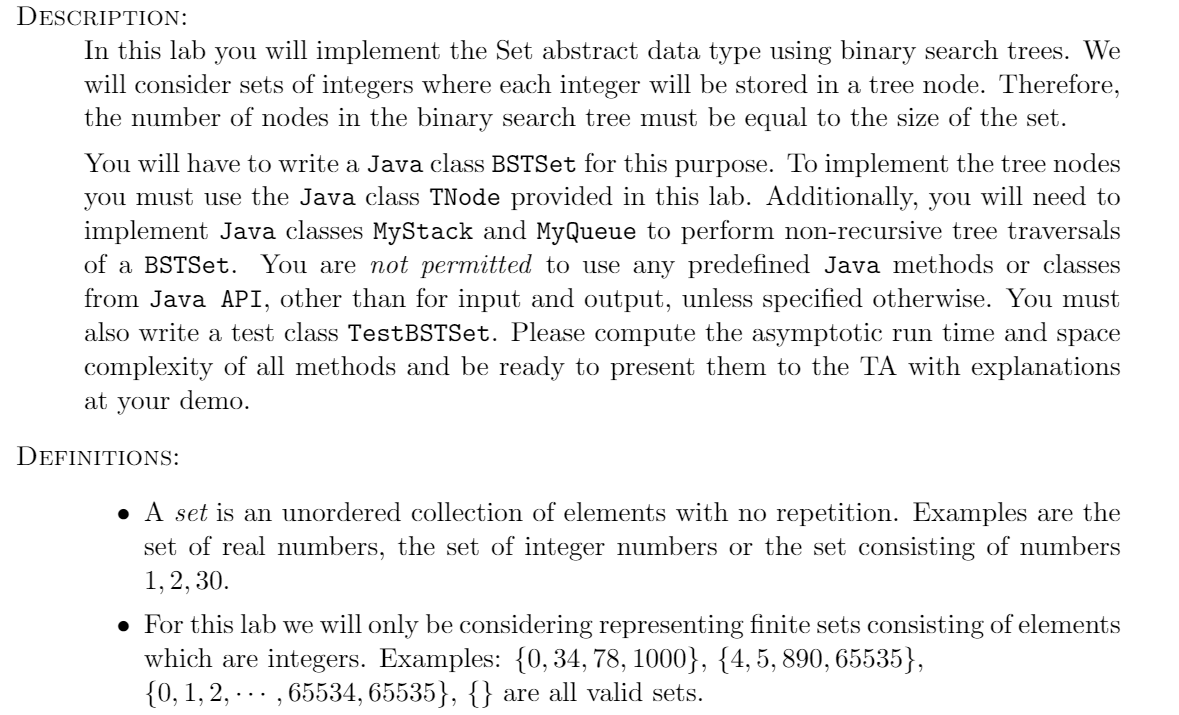
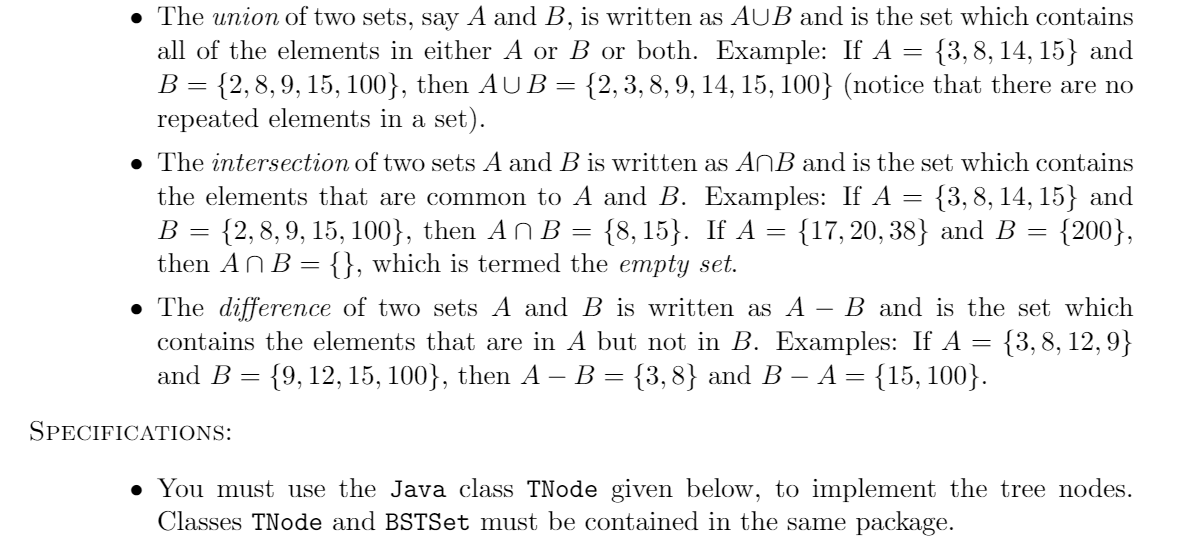
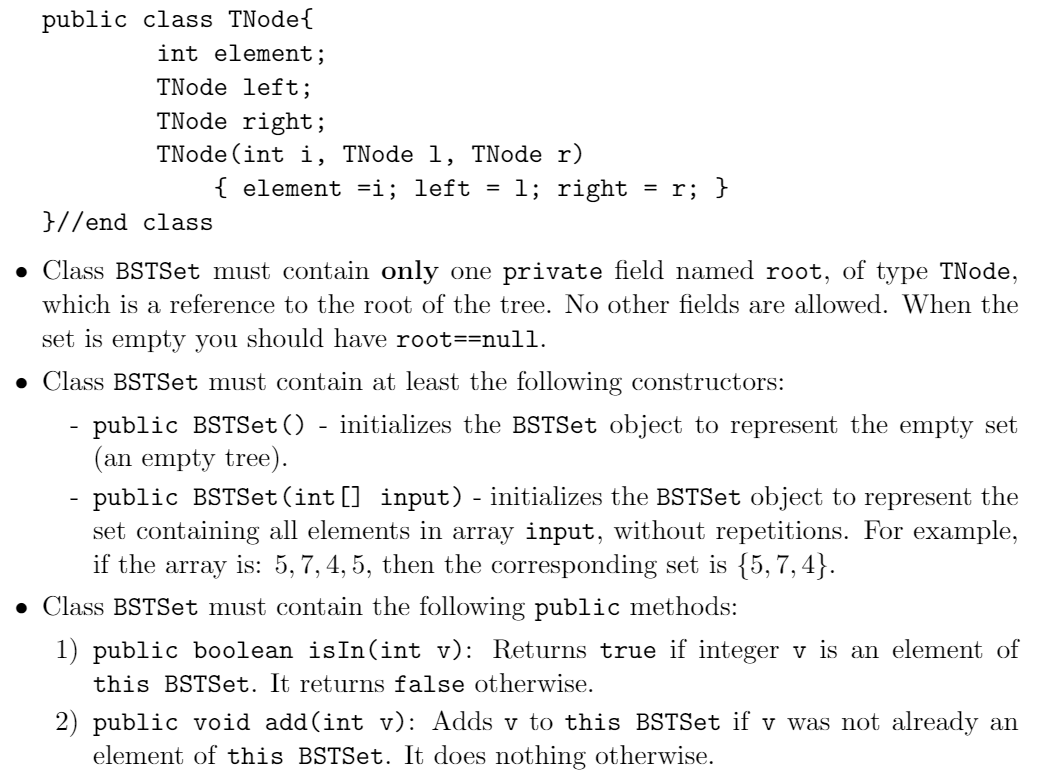


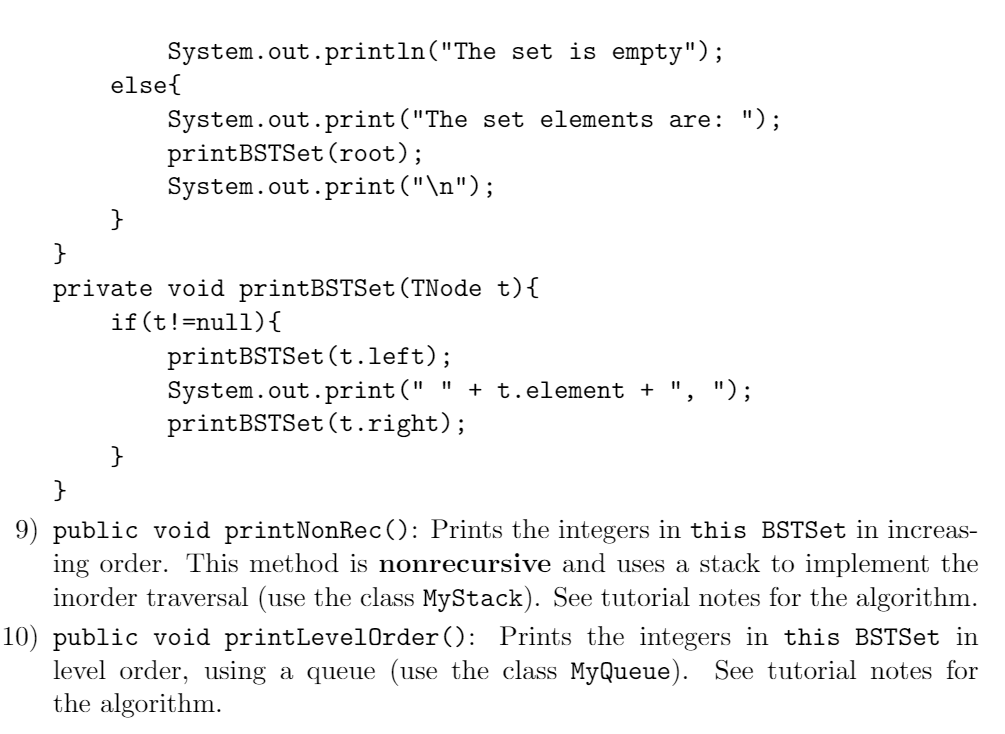
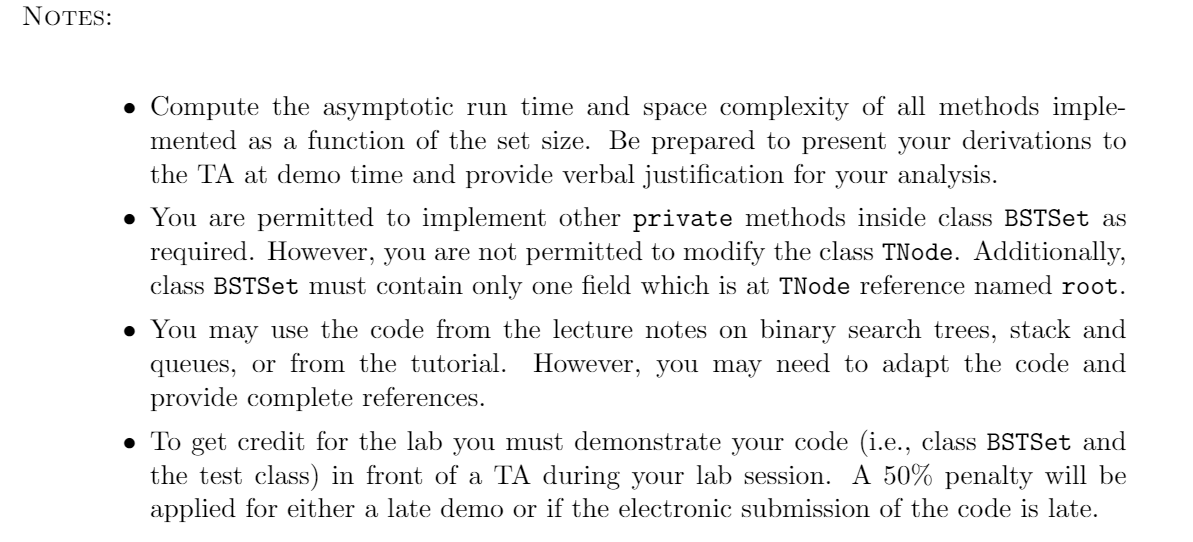
can someone help me code this in java?
NOTE: Please do not forget about the BSTSet Difference function. (#6)
DESCRIPTION: In this lab you will implement the Set abstract data type using binary search trees. We will consider sets of integers where each integer will be stored in a tree node. Therefore, the number of nodes in the binary search tree must be equal to the size of the set. You will have to write a Java class BSTSet for this purpose. To implement the tree nodes you must use the Java class TNode provided in this lab. Additionally, you will need to implement Java classes MyStack and MyQueue to perform non-recursive tree traversals of a BSTSet. You are not permitted to use any predefined Java methods or classes from Java API, other than for input and output, unless specified otherwise. You must also write a test class TestBSTSet. Please compute the asymptotic run time and space complexity of all methods and be ready to present them to the TA with explanations at your demo. DEFINITIONS: A set is an unordered collection of elements with no repetition. Examples are the set of real numbers, the set of integer numbers or the set consisting of numbers 1, 2, 30. For this lab we will only be considering representing finite sets consisting of elements which are integers. Examples: {0, 34, 78, 1000}, {4, 5, 890, 65535}, {0, 1, 2, ... ,65534, 65535}, {} are all valid sets. = The union of two sets, say A and B, is written as AUB and is the set which contains all of the elements in either A or B or both. Example: If A {3, 8, 14, 15} and B = {2,8,9, 15, 100}, then AUB = {2,3, 8, 9, 14, 15, 100} (notice that there are no repeated elements in a set). The intersection of two sets A and B is written as AnB and is the set which contains the elements that are common to A and B. Examples: If A : {3, 8, 14, 15} and B = {2, 8, 9, 15, 100}, then An B = {8, 15}. If A = {17, 20,38} and B = {200}, then An B = {}, which is termed the empty set. The difference of two sets A and B is written as A - B and is the set which contains the elements that are in A but not in B. Examples: If A = = {3, 8, 12,9} and B= {9, 12, 15, 100}, then A B = {3,8} and B A = {15, 100}. = SPECIFICATIONS: You must use the Java class TNode given below, to implement the tree nodes. Classes TNode and BSTSet must be contained in the same package. public class TNode{ int element; TNode left; TNode right; TNode(int i, TNode 1, TNode r) { element ri; left = 1; right }//end class = r; } Class BSTSet must contain only one private field named root, of type TNode, which is a reference to the root of the tree. No other fields are allowed. When the set is empty you should have root==null. Class BSTSet must contain at least the following constructors: - public BSTSet() - initializes the BSTSet object to represent the empty set (an empty tree). public BSTSet(int[] input) - initializes the BSTSet object to represent the set containing all elements in array input, without repetitions. For example, if the array is: 5, 7, 4, 5, then the corresponding set is {5,7,4}. Class BSTSet must contain the following public methods: 1) public boolean isIn(int v): Returns true if integer v is an element of this BSTSet. It returns false otherwise. 2) public void add(int v): Adds v to this BSTSet if v was not already an element of this BSTSet. It does nothing otherwise. 3) public boolean remove(int v): Removes v from this BSTSet if v was an element of this BSTSet and returns true. Returns false if v was not an element of this BSTSet. 4) public BSTSet union (BSTSet s): Returns a new BSTSet which represents the union of this BSTSet and s. This method should not modify the input sets. 5) public BSTSet intersection (BSTSet s): Returns a new BSTSet which rep- resents the intersection of this BSTSet and s. This method should not modify the input sets. 6) public BSTSet difference (BSTSet s): Returns a new BSTSet which repre- sents the difference of this BSTSet and s. This method should not modify the input sets. 7) public int size(): Returns the number of elements in this set. 8) public int height(): Returns the height of this BSTSet. Height of empty set is -1. 9) public void printBSTSet(): Outputs the elements of this set to the con- sole, in increasing order. private void printBSTSet (TNode t): Outputs to the console the elements stored in the subtree rooted in t, in increasing order. For the two printing methods specified above you must use the following code public void printBSTSet() { if (root==null) System.out.println("The set is empty"); else{ System.out.print("The set elements are: "); printBSTSet (root); System.out.print(" "); } } private void printBSTSet (TNode t){ if(t!=null){ printBSTSet(t.left); System.out.print("" + t.element + ", "); printBSTSet(t.right); } } 9) public void printNonRec(): Prints the integers in this BSTSet in increas- ing order. This method is nonrecursive and uses a stack to implement the inorder traversal (use the class MyStack). See tutorial notes for the algorithm. 10) public void printLevelOrder(): Prints the integers in this BSTSet in level order, using a queue (use the class MyQueue). See tutorial notes for the algorithm. NOTES: Compute the asymptotic run time and space complexity of all methods imple- mented as a function of the set size. Be prepared to present your derivations to the TA at demo time and provide verbal justification for your analysis. You are permitted to implement other private methods inside class BSTSet as required. However, you are not permitted to modify the class TNode. Additionally, class BSTSet must contain only one field which is at TNode reference named root. You may use the code from the lecture notes on binary search trees, stack and queues, or from the tutorial. However, you may need to adapt the code and provide complete references. To get credit for the lab you must demonstrate your code (i.e., class BSTSet and the test class) in front of a TA during your lab session. A 50% penalty will be applied for either a late demo or if the electronic submission of the code is late. DESCRIPTION: In this lab you will implement the Set abstract data type using binary search trees. We will consider sets of integers where each integer will be stored in a tree node. Therefore, the number of nodes in the binary search tree must be equal to the size of the set. You will have to write a Java class BSTSet for this purpose. To implement the tree nodes you must use the Java class TNode provided in this lab. Additionally, you will need to implement Java classes MyStack and MyQueue to perform non-recursive tree traversals of a BSTSet. You are not permitted to use any predefined Java methods or classes from Java API, other than for input and output, unless specified otherwise. You must also write a test class TestBSTSet. Please compute the asymptotic run time and space complexity of all methods and be ready to present them to the TA with explanations at your demo. DEFINITIONS: A set is an unordered collection of elements with no repetition. Examples are the set of real numbers, the set of integer numbers or the set consisting of numbers 1, 2, 30. For this lab we will only be considering representing finite sets consisting of elements which are integers. Examples: {0, 34, 78, 1000}, {4, 5, 890, 65535}, {0, 1, 2, ... ,65534, 65535}, {} are all valid sets. = The union of two sets, say A and B, is written as AUB and is the set which contains all of the elements in either A or B or both. Example: If A {3, 8, 14, 15} and B = {2,8,9, 15, 100}, then AUB = {2,3, 8, 9, 14, 15, 100} (notice that there are no repeated elements in a set). The intersection of two sets A and B is written as AnB and is the set which contains the elements that are common to A and B. Examples: If A : {3, 8, 14, 15} and B = {2, 8, 9, 15, 100}, then An B = {8, 15}. If A = {17, 20,38} and B = {200}, then An B = {}, which is termed the empty set. The difference of two sets A and B is written as A - B and is the set which contains the elements that are in A but not in B. Examples: If A = = {3, 8, 12,9} and B= {9, 12, 15, 100}, then A B = {3,8} and B A = {15, 100}. = SPECIFICATIONS: You must use the Java class TNode given below, to implement the tree nodes. Classes TNode and BSTSet must be contained in the same package. public class TNode{ int element; TNode left; TNode right; TNode(int i, TNode 1, TNode r) { element ri; left = 1; right }//end class = r; } Class BSTSet must contain only one private field named root, of type TNode, which is a reference to the root of the tree. No other fields are allowed. When the set is empty you should have root==null. Class BSTSet must contain at least the following constructors: - public BSTSet() - initializes the BSTSet object to represent the empty set (an empty tree). public BSTSet(int[] input) - initializes the BSTSet object to represent the set containing all elements in array input, without repetitions. For example, if the array is: 5, 7, 4, 5, then the corresponding set is {5,7,4}. Class BSTSet must contain the following public methods: 1) public boolean isIn(int v): Returns true if integer v is an element of this BSTSet. It returns false otherwise. 2) public void add(int v): Adds v to this BSTSet if v was not already an element of this BSTSet. It does nothing otherwise. 3) public boolean remove(int v): Removes v from this BSTSet if v was an element of this BSTSet and returns true. Returns false if v was not an element of this BSTSet. 4) public BSTSet union (BSTSet s): Returns a new BSTSet which represents the union of this BSTSet and s. This method should not modify the input sets. 5) public BSTSet intersection (BSTSet s): Returns a new BSTSet which rep- resents the intersection of this BSTSet and s. This method should not modify the input sets. 6) public BSTSet difference (BSTSet s): Returns a new BSTSet which repre- sents the difference of this BSTSet and s. This method should not modify the input sets. 7) public int size(): Returns the number of elements in this set. 8) public int height(): Returns the height of this BSTSet. Height of empty set is -1. 9) public void printBSTSet(): Outputs the elements of this set to the con- sole, in increasing order. private void printBSTSet (TNode t): Outputs to the console the elements stored in the subtree rooted in t, in increasing order. For the two printing methods specified above you must use the following code public void printBSTSet() { if (root==null) System.out.println("The set is empty"); else{ System.out.print("The set elements are: "); printBSTSet (root); System.out.print(" "); } } private void printBSTSet (TNode t){ if(t!=null){ printBSTSet(t.left); System.out.print("" + t.element + ", "); printBSTSet(t.right); } } 9) public void printNonRec(): Prints the integers in this BSTSet in increas- ing order. This method is nonrecursive and uses a stack to implement the inorder traversal (use the class MyStack). See tutorial notes for the algorithm. 10) public void printLevelOrder(): Prints the integers in this BSTSet in level order, using a queue (use the class MyQueue). See tutorial notes for the algorithm. NOTES: Compute the asymptotic run time and space complexity of all methods imple- mented as a function of the set size. Be prepared to present your derivations to the TA at demo time and provide verbal justification for your analysis. You are permitted to implement other private methods inside class BSTSet as required. However, you are not permitted to modify the class TNode. Additionally, class BSTSet must contain only one field which is at TNode reference named root. You may use the code from the lecture notes on binary search trees, stack and queues, or from the tutorial. However, you may need to adapt the code and provide complete references. To get credit for the lab you must demonstrate your code (i.e., class BSTSet and the test class) in front of a TA during your lab session. A 50% penalty will be applied for either a late demo or if the electronic submission of the code is lateStep by Step Solution
There are 3 Steps involved in it
Step: 1

Get Instant Access to Expert-Tailored Solutions
See step-by-step solutions with expert insights and AI powered tools for academic success
Step: 2

Step: 3

Ace Your Homework with AI
Get the answers you need in no time with our AI-driven, step-by-step assistance
Get Started


